While Hawaii is known for its beaches, hikes, and culture, camping in Hawaii is an experience not to be missed. We’ve compiled a guide with everything you’ll need to know before planning a successful and legal camping trip in Hawaii.
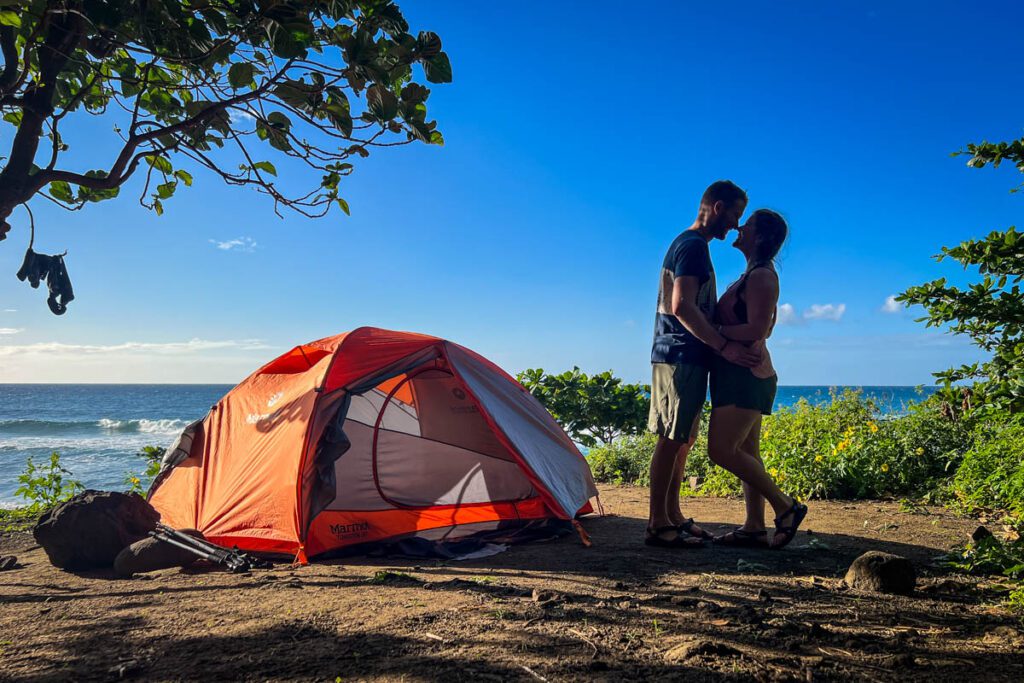
Written by guest author: Rachel Grenis
From lush rainforests and cascading waterfalls to pristine beaches and volcanic vistas, Hawaii is the perfect place to plan an epic camping adventure. After a month of living out of a campervan in Oahu, it’s safe to say we learned a lot about camping in Hawaii.
Whether you want to rent a campervan in Hawaii or do some backpacking around the islands, you’ll need to be prepared and equipped with tons of important information.
It may sound easy, but legally camping in Hawaii is a bit more complicated than it sounds. In this article I’m going to share all of the tips and tricks that helped us plan a successful Hawaii camping trip.
Hawaii camping guide
- Why go camping in Hawaii
- Our experience camping in Hawaii
- Rules for camping in Hawaii
- Tent camping vs. campervan
- Hawaii camping rentals
- How to find campsites in Hawaii
- Hawaii camping FAQs
- What to pack for camping in Hawaii
If you’re planning a trip to Hawaii, we have the ultimate resource for you!
This FREE PDF download includes everything you’re going to want to pack for your Hawaiian vacation, including what NOT to bring, plus tons of insider tips!
Sign up for our ultimate Hawaii packing list now and get a copy sent straight to your inbox.
Why go camping in Hawaii?
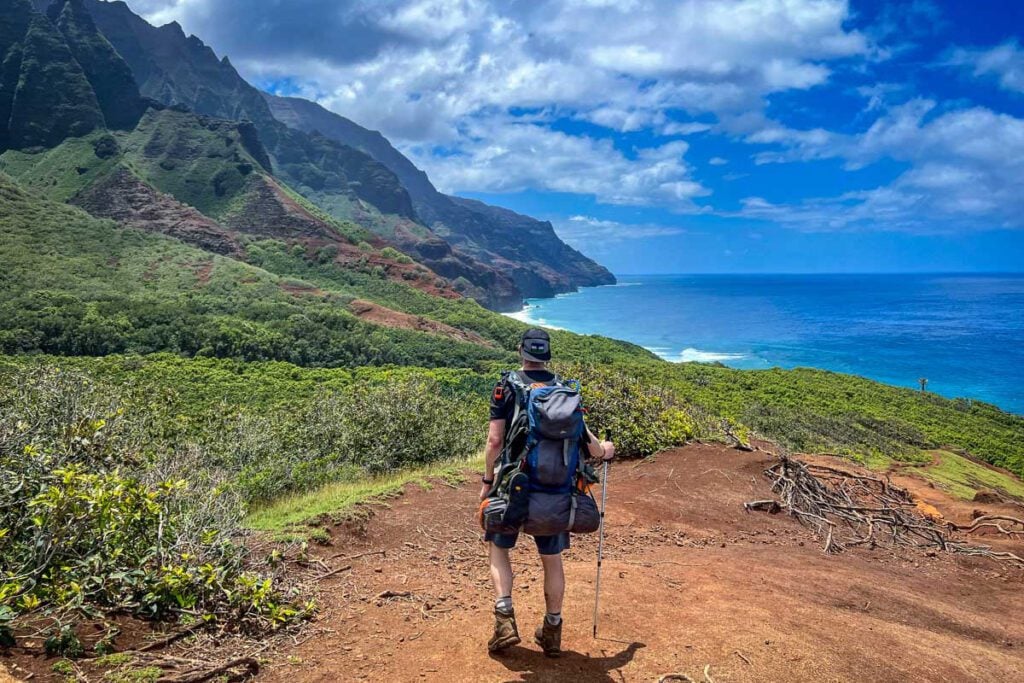
If you love off-the-beaten-path adventures, Hawaii might not be your first thought.
With its whopping 10,000,000 tourists each year, visitors usually find themselves packed like sardines in Honolulu and Maui high-rise resorts and boutique hotels.
However, there is so much more to these destinations once you get off the beaten tourist path.
Our solution: planning a camping trip in Hawaii! There are off-grid and on-the-beach camp sites on almost every Hawaiian island.
Why was this such an amazing idea?
It’s the best way to see the islands
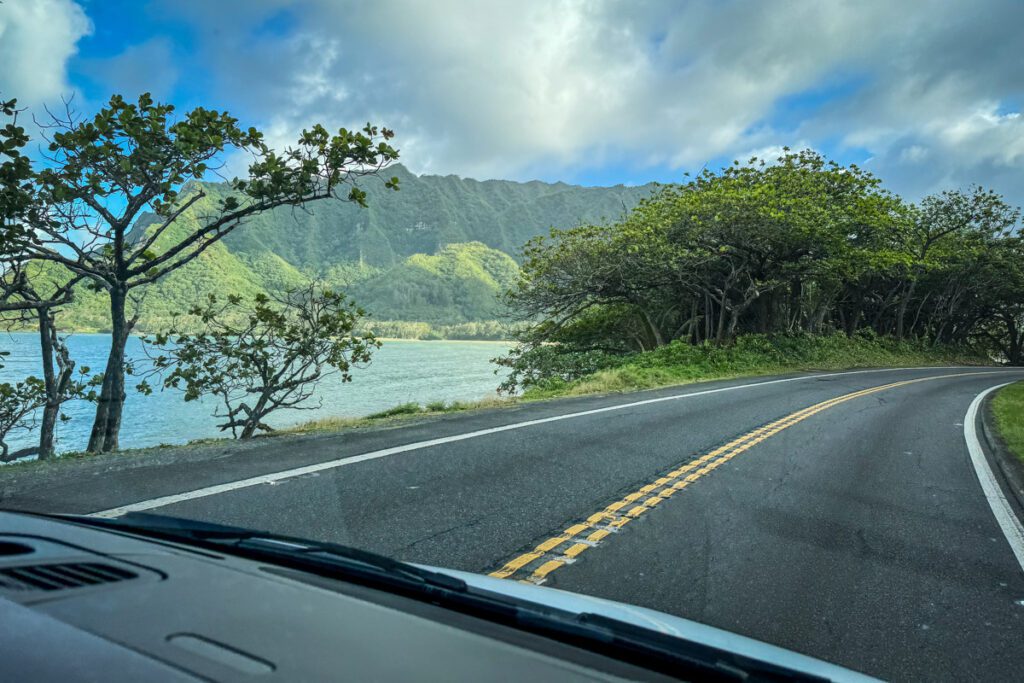
I believe camping in Hawaii is the best way to see the islands, truly.
There are very few hotels and resorts outside of Waikiki, so if you want to spend time on the North Shore or the Windward side of the island, you’ve got to hop in your car for the day and drive back to your hotel every night.
It turns into spending hours in a car, which is simply a waste of valuable island time!
It’s affordable
Whether car camping or tent camping, this is one of the cheapest ways to visit Hawaii. You can get permits around the islands for as little as $10/night.
You’ll find some beautiful spots you may not find otherwise
Having the time and ability to walk and drive around the island means really getting to explore the ins and outs. It’s hard not to stumble upon some hidden gems. From waterfalls to cliff jumping, the local spots you’ll get to hit while camping are next to none.
Our experience camping in Hawaii
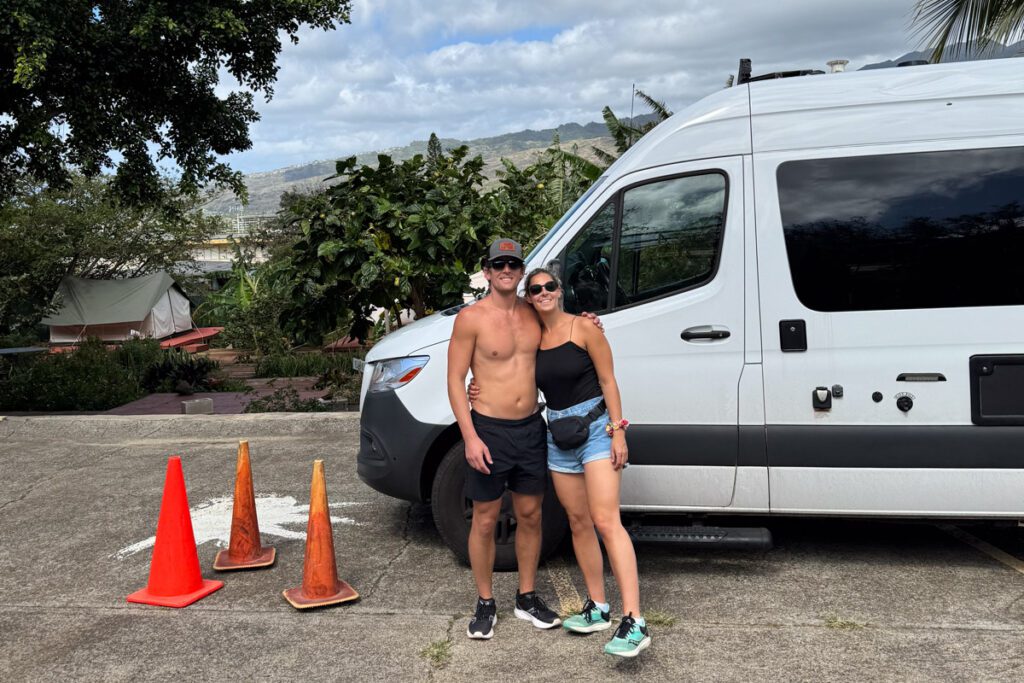
We spent one month living in a campervan and camping our way around the island of Oahu.
Camping in Hawaii was one of my favorite travel experiences and I would recommend it to anyone who wants to see a different, less touristy side of the state. I loved the ability to wake up and spend quality time in different parts of the island.
We were able to hit all the trails we wanted to hike and make stops at museums, beaches, and food trucks along the way.
During the evenings at our campsites I spent lots of time chatting with the owners for suggestions on what to do next and made some great new friends.
Planning around the regulations did require a bit of forethought. Making sure we did everything legally and had planned out places to sleep every night was the most stressful part.
We booked most of our campsites through Hipcamp ahead of time. The earlier you book the more options you have. There were a few days we left open to adjust for changes in planning.
On the days we booked last minute, we were choosing between 2-4 sites, which worked out just fine. Some of the sites are so cool and unique, staying there is an experience within itself.
I know it may not be for everyone, but I’ll be opting for camping over a resort again next time I’m in Hawaii!
Rules for camping in Hawaii
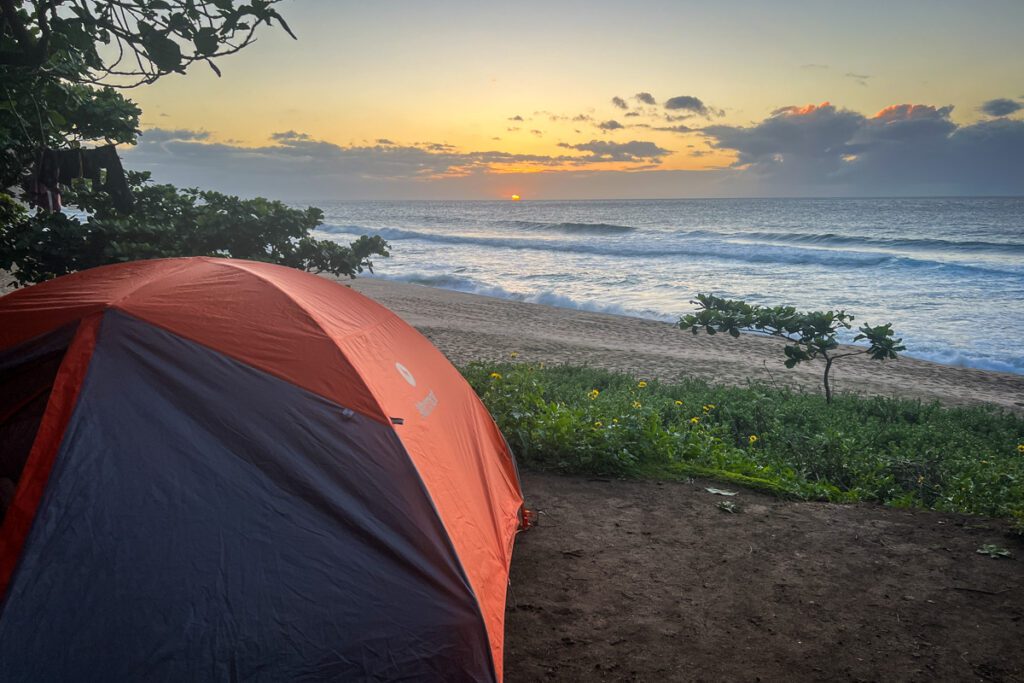
Camping on the Hawaiian islands isn’t as easy as pitching a tent and heading to sleep. In fact, there are loads of logistics and laws you’ll need to know to prepare for a safe, successful, and legal Hawaii camping trip.
1. There is no free camping in Hawaii
The first, and most important, thing anyone thinking about camping in Hawaii should know: there is no free camping on any island in Hawaii.
Hawaii law “prohibits living or sleeping in parked vehicles between 6:00 p.m. and 6:00 a.m”.
This includes beaches, state parks, and any public land. So think again if you planned to just wing it and find a quiet neighborhood to park in overnight.
2. You have to purchase and print your permit ahead of time
Spontaneous planning is not the way to go for this particular trip. You’ll need access to a printer to obtain your permit for each campsite.
Even if you have access to a printer, sites still tend to book up, so you’ll have a harder time finding the right spot at the last minute.
On the bright side, campsites open up no less than 30 days in advance, so you have plenty of time to plan before your trip.
Insider tip: You’ll have to create an account on the official Hawaii camping site to reserve your campsites.
3. You cannot stay at one campsite for more than 5 consecutive nights
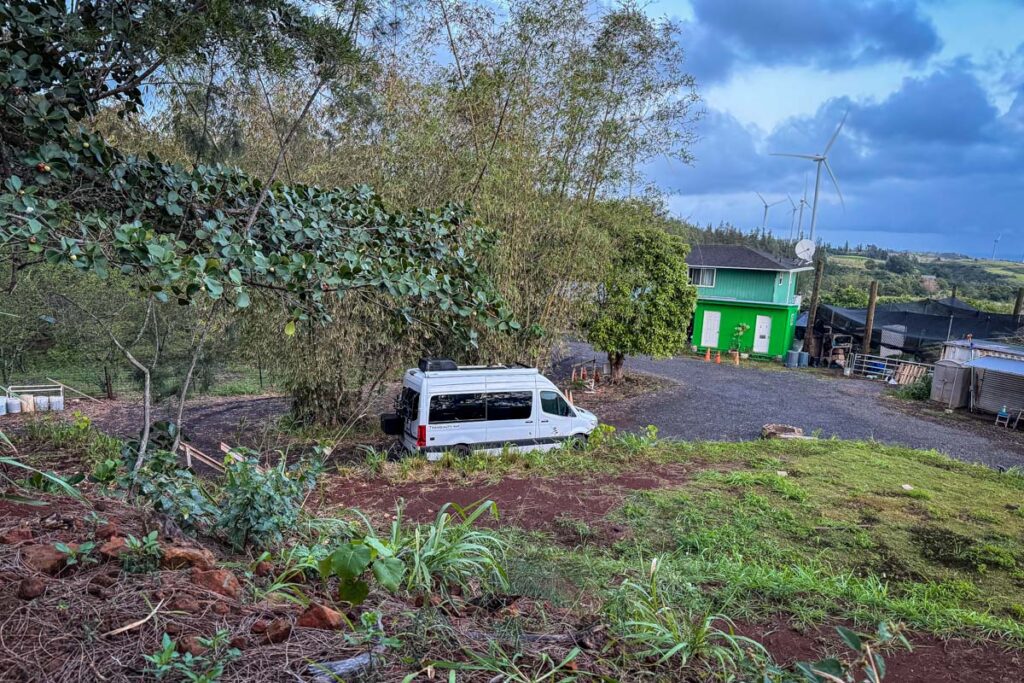
Campsites in Hawaii have a 5 night limit. If you’re staying longer than 5 nights, you’ll have to move sites. That’s okay though, I think it’s best to try out different campsites as opposed to staying in one place your whole trip.
4. You must have a valid Hawaii driver’s license to receive the resident rate
Camping permits for nonresidents, on average, cost $30. If you are a resident, it’s $20. Residents, be sure to have your license handy for booking.
5. State parks are closed Wednesdays and Thursdays
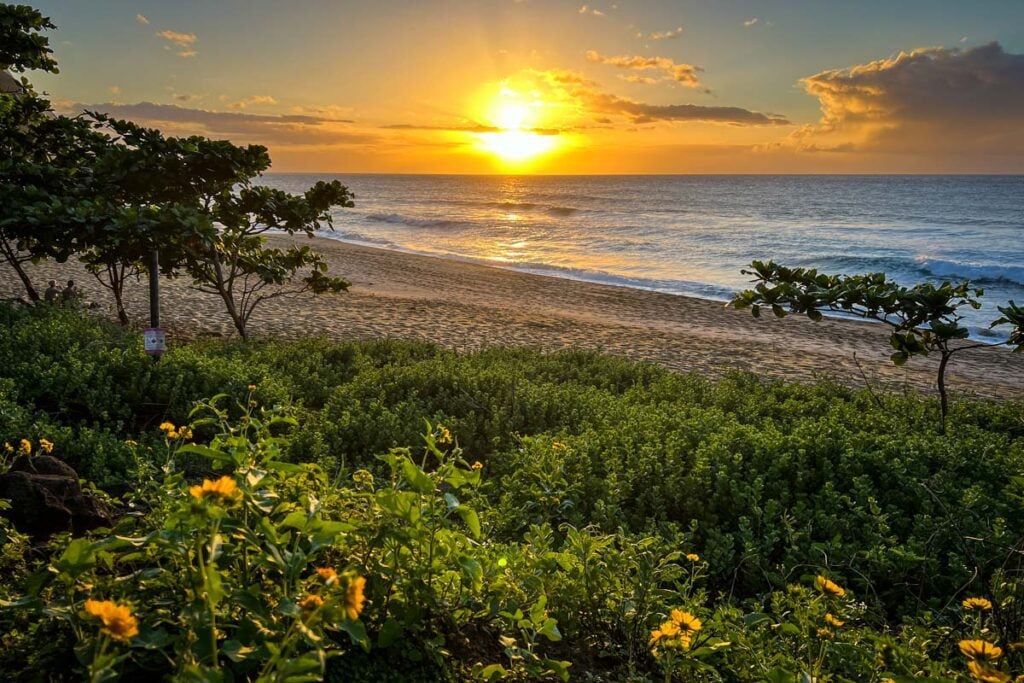
Keep an eye out for which sites are available throughout the week. State Parks in Oahu are closed on Wednesday and Thursday, while other sites on the Big Island offer weekend camping only.
There are still plenty of Forest Reserve sites to choose from on each island, you just have to check out the reservation system to see what’s available on each island for your chosen dates.
If you can’t find a site you want to stay in those nights, splurge for a hostel, or even a hotel, for a night! Being so affordable, hostels fill up quickly, so I’d suggest planning these at least a month in advance.
6. You’ll need to bring your own grill
This depends on the site, but not all campsites in Hawaii offer fire rings. If you choose a site with no ring, be sure to bring your own grill or fire containment device.
Luckily, the website you’ll book your campsites on makes it super easy to see what amenities are and aren’t available at each site.
Tent camping vs. campervan
Choosing a tent or a campervan to go camping in Hawaii can be a difficult decision as each offers a very different experience.
Pros and cons of tent camping
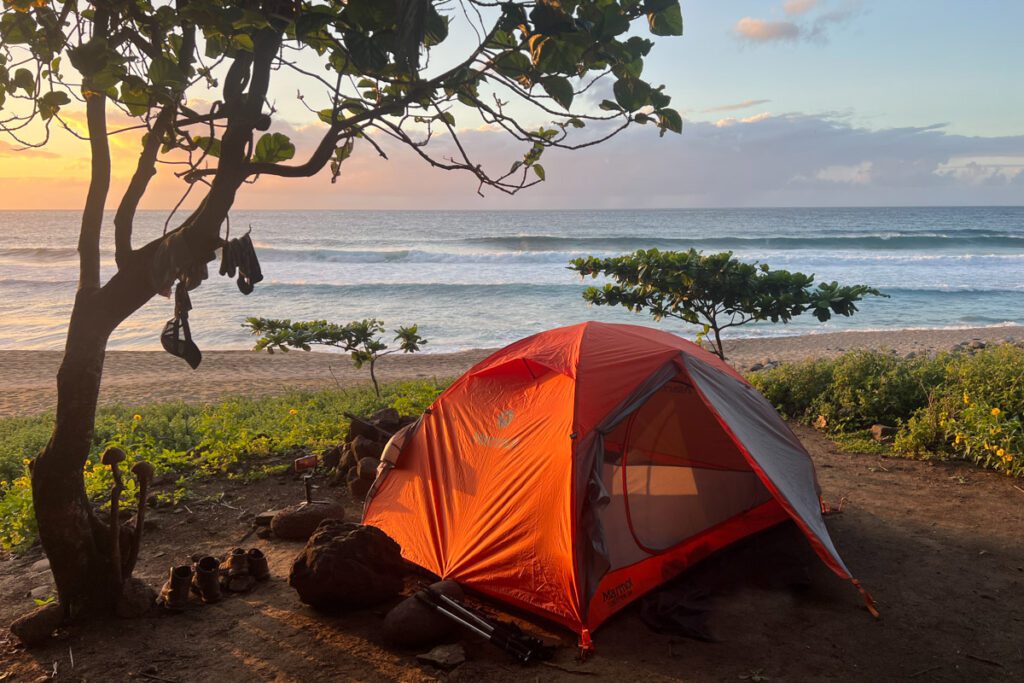
The best part about tent camping in Hawaii is there are tons of spectacular campsites—from nitty gritty, off-road to right on the beach. They’re quiet, you’re out in nature, and you’re getting the true camping experience. Tent camping in Hawaii is also the cheaper option, if affordability is your priority.
However, not all campsites are set up for comfort. Some don’t have showers, some don’t have water, and some don’t even have restrooms.
Pay attention when booking and be prepared for the amenities, or lack thereof, at each campsite you book. This could turn into a hassle of lugging around additional food, water, and supplies.
Lastly, and one of the reasons I opted for a campervan instead, is the potential to get stuck in bad weather. The weather in Hawaii can be volatile throughout the day and night, depending on the time of year.
There was a night when the rain and wind were so bad it nearly broke our awning. I was grateful to not be in a tent for that particular storm!
Psst! For an in-depth guide on the seasonal weather patterns and other factors, check out our complete guide on the best time to visit Hawaii.
Pros and cons of campervan camping
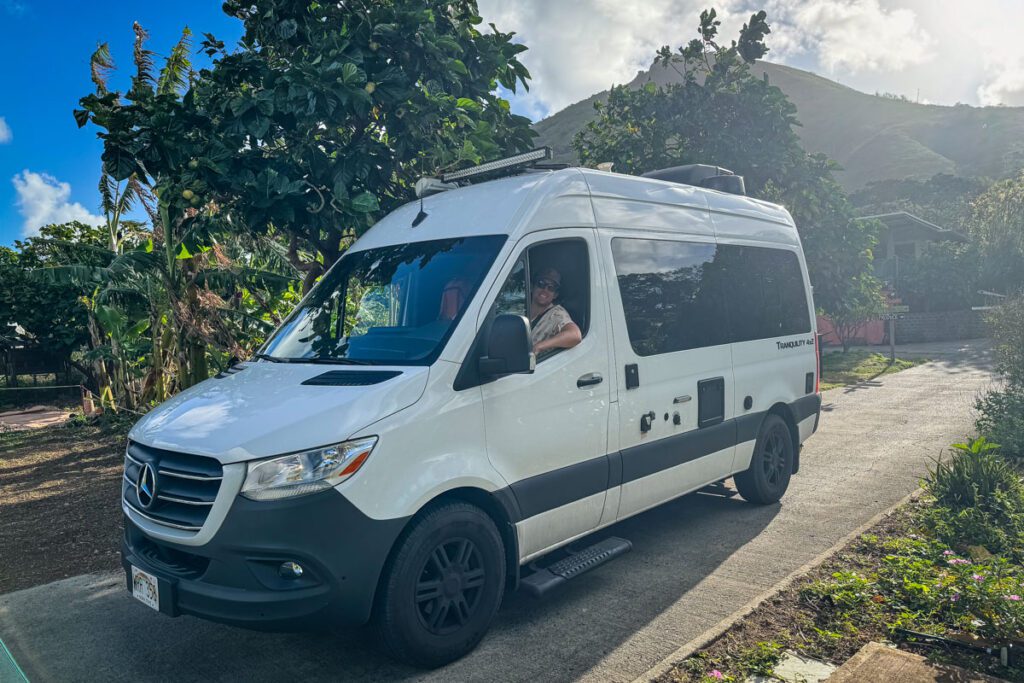
Having a home and bed in one is the biggest convenience of opting for a campervan. You don’t have to pack or unpack; everything stays with you! You also have the option of additional amenities.
Our campervan rental had a shower, water, sink, bathroom, and refrigerator, so we didn’t have to worry about campsite amenities. I also prefer the safety and shelter of being in a car.
On the flip side, Hawaii is simply not very campervan-friendly. There’s only one park that officially allows campervans.
The campervan option relies on finding private campgrounds as opposed to state grounds. Of course, this option is a little more expensive, costing on average $40-$60/night when the tent campsites go for about $30/night.
Hawaii camping rentals
There are rentals available on every island for gear or campervans. Here are a few options:
Oahu
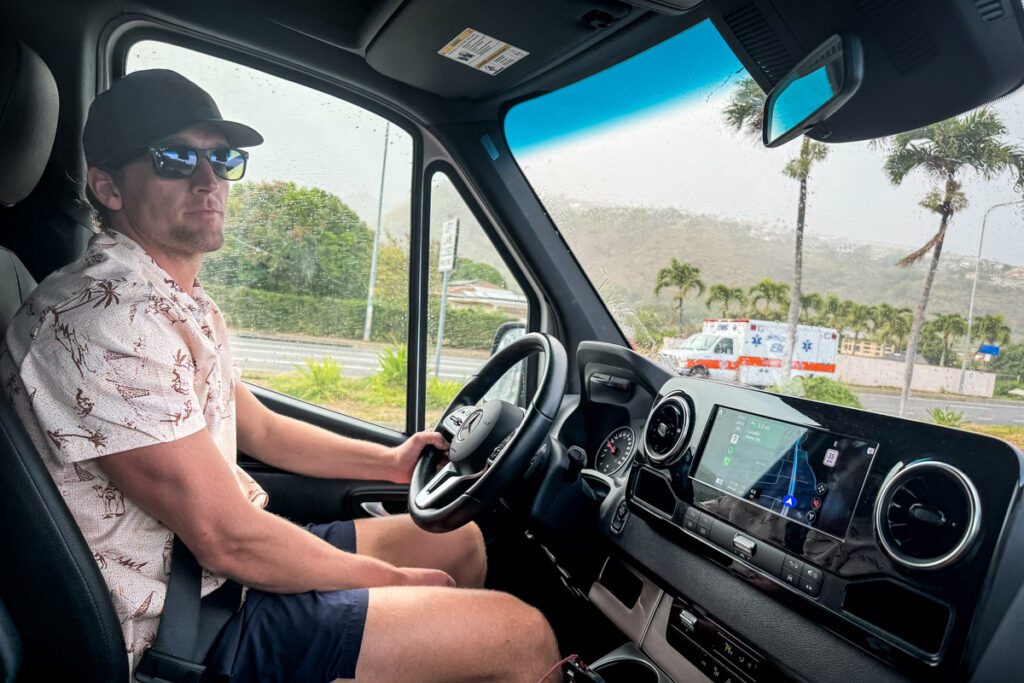
- Campervan rentals: Hw Campervans and Outdoorsy offer a variety of converted campervans (logo free!)
- Camping gear: You can find all the camping gear you need at Surfboard Rentals Hawaii. Camp Mokuleia and Sun Farms Hawaii offer premade tent setups.
Pro tip: Outdoorsy comes with insurance so it’s a great option if you want more protection during your trip. This is what we used.
The owner of the campervan we rented tried to file a claim against us. Thankfully, Outdoorsy’s insurance claims center reviewed and dropped it. Always remember to take before and after photos for rentals!
Kauai
- Campervan rentals: Kauai Rooftop Campers and Outdoorsy
- Camping gear: Pitch a Tent Kauai is a one-stop-shop for tent or car camping; they even have freeze-dried food options! Kayak Kauai is another great option.
Psst! Check out our guide to the best things to do in Kauai while you’re there!
Big Island
- Campervan rentals: Camper Vans Big Island and Big Island Campers. I’d say the Big Island has the most private and public campsite options for campervans.
- Camping gear: There aren’t many places to rent equipment here, so this option will likely be difficult if you’re not bringing your own gear. Hawaii Volcano House has a tent rental option, but you have to stay on-site.
Before you go, be sure you read our Big Island bucket list!
If you decide to go the campervan route, we have more rental company options for Oahu, Kauai, Big Island, and Maui in our Hawaii campervan rental guide.
How to find campsites in Hawaii
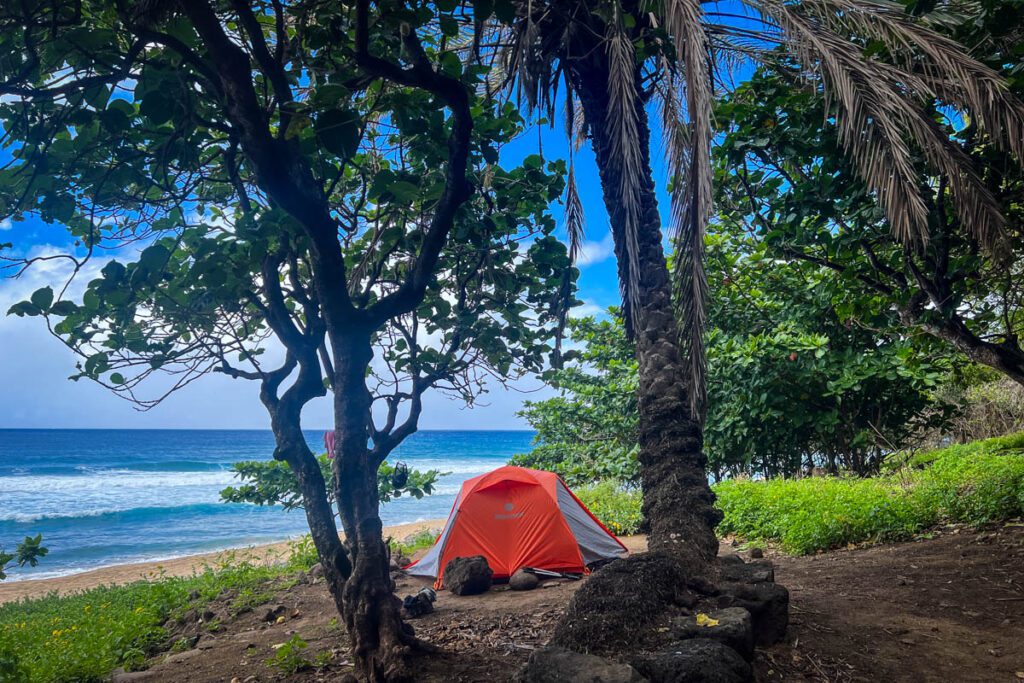
It’s not hard finding campsites in Hawaii once you know where to go! Here’s how I planned out our routes:
Hawaii Government Booking Site
This is for tent campers booking state park sites. You can search and book your campsites (for any island) directly on Hawaii’s government booking site.
Filter by the island you’re visiting and check out the sites and amenities available at each park. Parking permits are sold separately sometimes, so make sure you also have a permit for your car in the lot.
Hipcamp
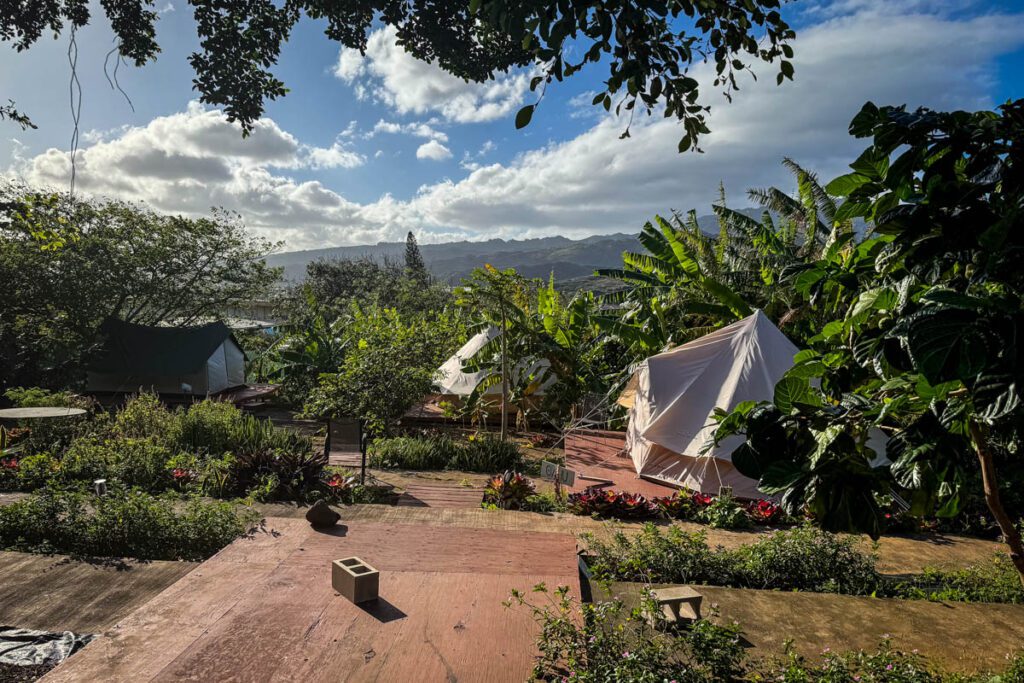
This is great for campervan renters booking private sites. Hipcamp is a resource for finding unique stays listed by private landowners. In Hawaii, this usually means private farms—we stayed on farms with chickens, cats, and even a baby goat! We also stayed on a fruit farm near Koko Head, which ended up being my favorite experience of the trip.
Private sites
On some islands, there are private sites that won’t be listed on the state website or Hipcamp, but they’re out there! A good example is Malaekahana Beach Campground on Oahu. It’s the only official campsite (and the cheapest) for campervans. They have tent sites as well.
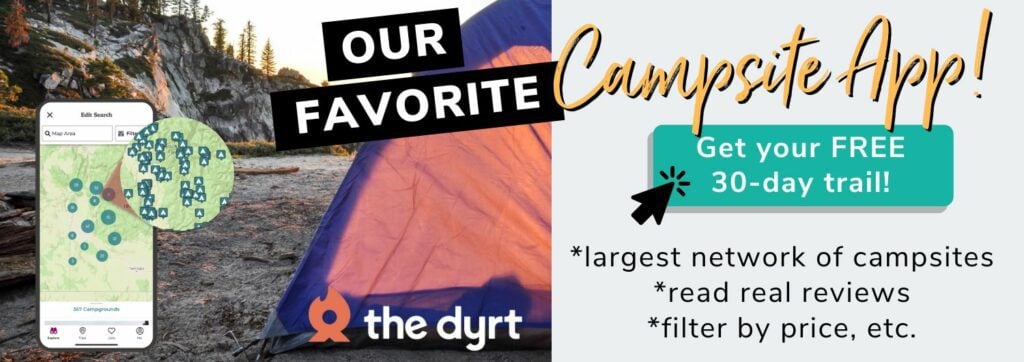
Psst! Download our favorite camping app, The Dyrt, so you can find nearby campsites and read through reviews before you head into the wilderness. We found Malaekahana listed on The Dyrt, even when it was unlisted on Hipcamp. Use this link to get access to the Pro Membership for 30 days completely free.
Hawaii camping FAQs
There is a lot to think about when it comes to camping in Hawaii. Let’s go over some common questions and see if we can get them answered!
Can I camp anywhere in Hawaii?
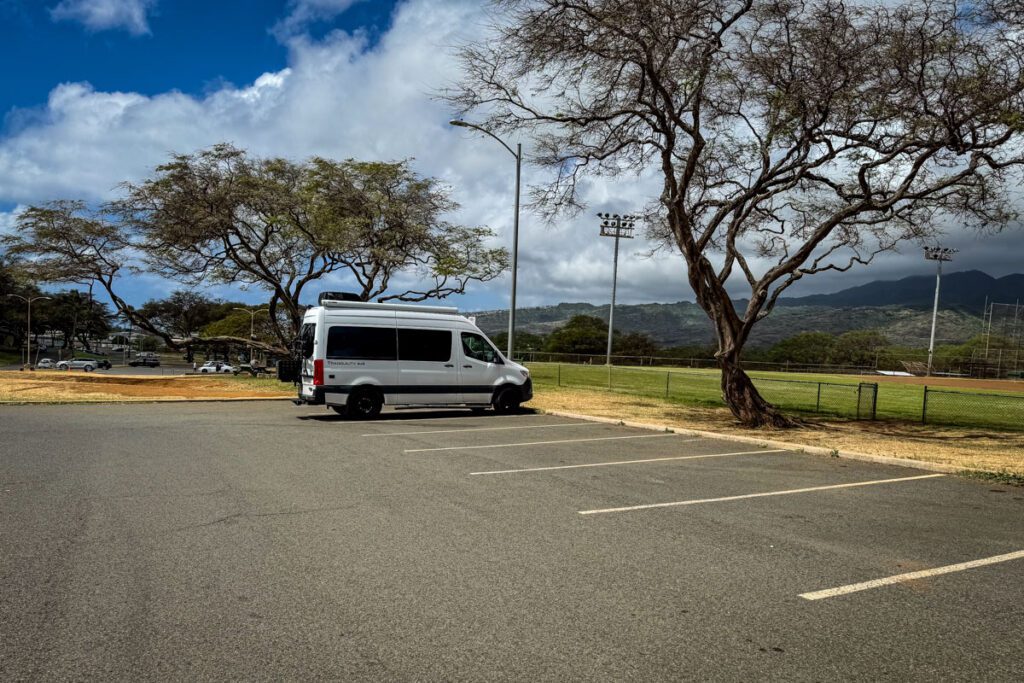
No – Hawaii has strict rules about camping.
You must have a permit for a state park or permission to be on private land to camp in Hawaii. Additionally, no person may sleep in their car between 6 p.m. and 6 a.m. on state land, beaches, parking lots, or neighborhoods.
How much does it cost to camp in Hawaii?
Camping in Hawaii can be an affordable alternative to staying in hotels. State-owned campsites range from $10-$30 per night, while privately owned sites range from $20-$70 per night, on average.
How can I camp for free in Hawaii?
There is no free camping in Hawaii. There is a state law that prohibits any free camping in the state.
Is it legal to camp on the beach in Hawaii?
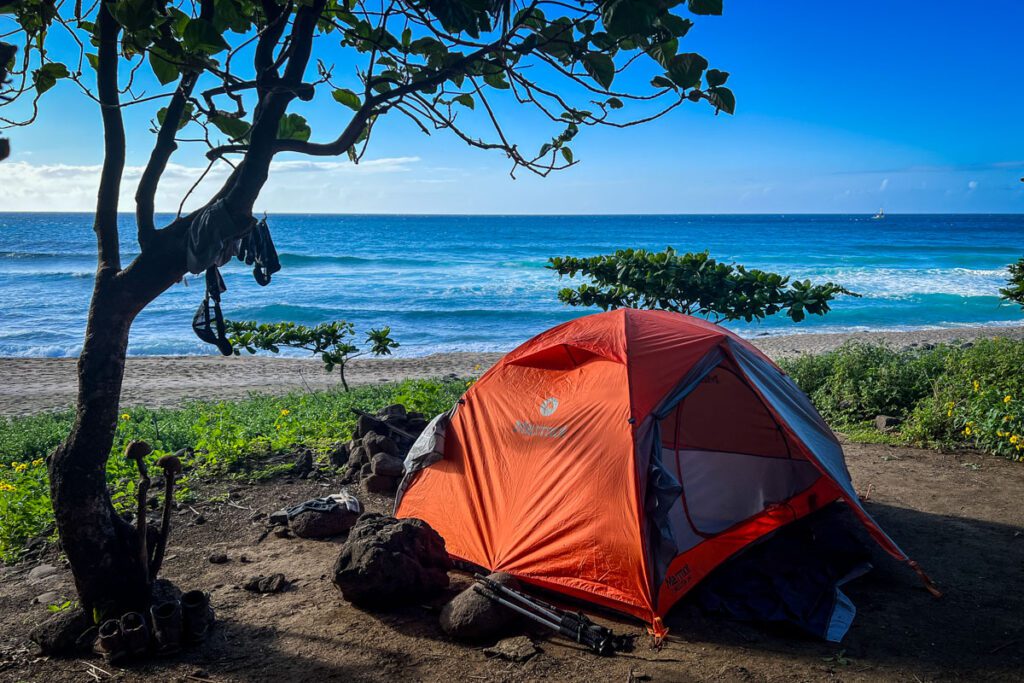
It is only legal to camp on the beach in Hawaii if you are at a designated campground with a purchased permit.
Can I sleep in my car in Hawaii?
Generally, no, you cannot sleep in your car in Hawaii. The only way to sleep in your car in Hawaii is if you are at a private campground with permission from the owner.
What to pack for camping in Hawaii
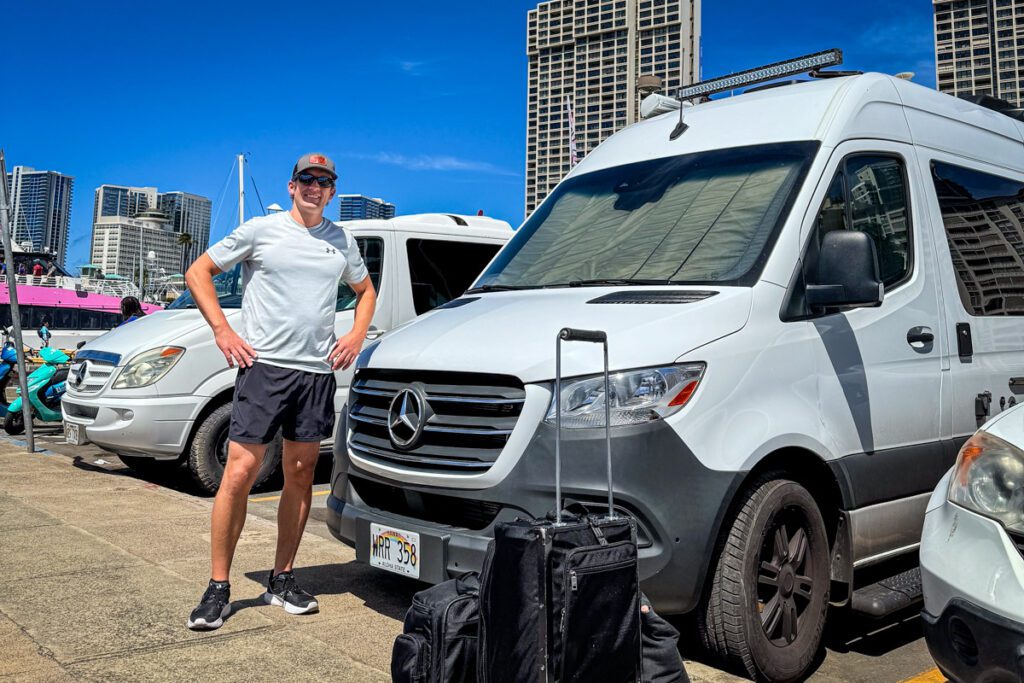
Along with your clothing luggage, here are a few things you’ll want to pack or look into renting for your camping trip in Hawaii.
General gear
- rain jacket
- bug spray
- comfortable hiking shoes (Chacos work great in Hawaii!)
- insulated water bottle
- bathing suit
- towel
- reef-safe sunscreen
- dry bag
- day pack
- headlamp
- first aid kit
- flip flops for shower and beach
Backpacking gear
- hiking backpack with a rain cover
- lightweight tent (this is similar to the one we have)
- sleeping bag rated for warm temperatures is best if possible (we used this one and it worked well)
- Alternatively, a sleeping bag liner could also be sufficient as the temperatures stay quite warm through the night)
- ultralight sleeping pad (this is the one we use)
- camping pillow (optional)
- We have this one, but opted not to bring it to save space. Instead, we balled up our rain jackets and used them as pillows.
- navigation (physical map or AllTrails loaded on phone along with a portable battery charger)
- toiletries: soap, shampoo, conditioner, deodorant, cleansing wipes
- toilet kit: lightweight poo shovel, toilet paper, ziplock bag for storing, second ziplock bag for used TP, Kula cloth
- backpacking stove (like a Jetboil)
- propane: you can’t fly with this, so you’ll need to pick it up once you get to Hawaii
- lighter and/or matches
- freeze-dried food and kitchen supplies (utensils, bowls, plates)
Be sure to download our complete packing list for Hawaii! It’s packed with good suggestions and insider tips to help plan your Hawaii trip. And it’s completely FREE, so why not!?
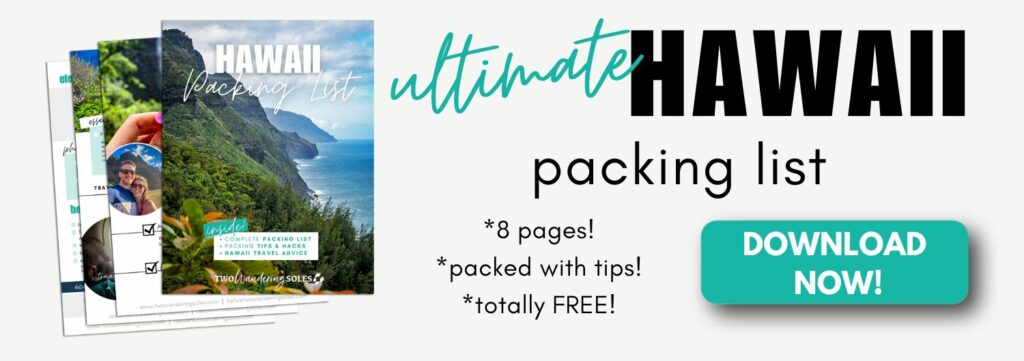
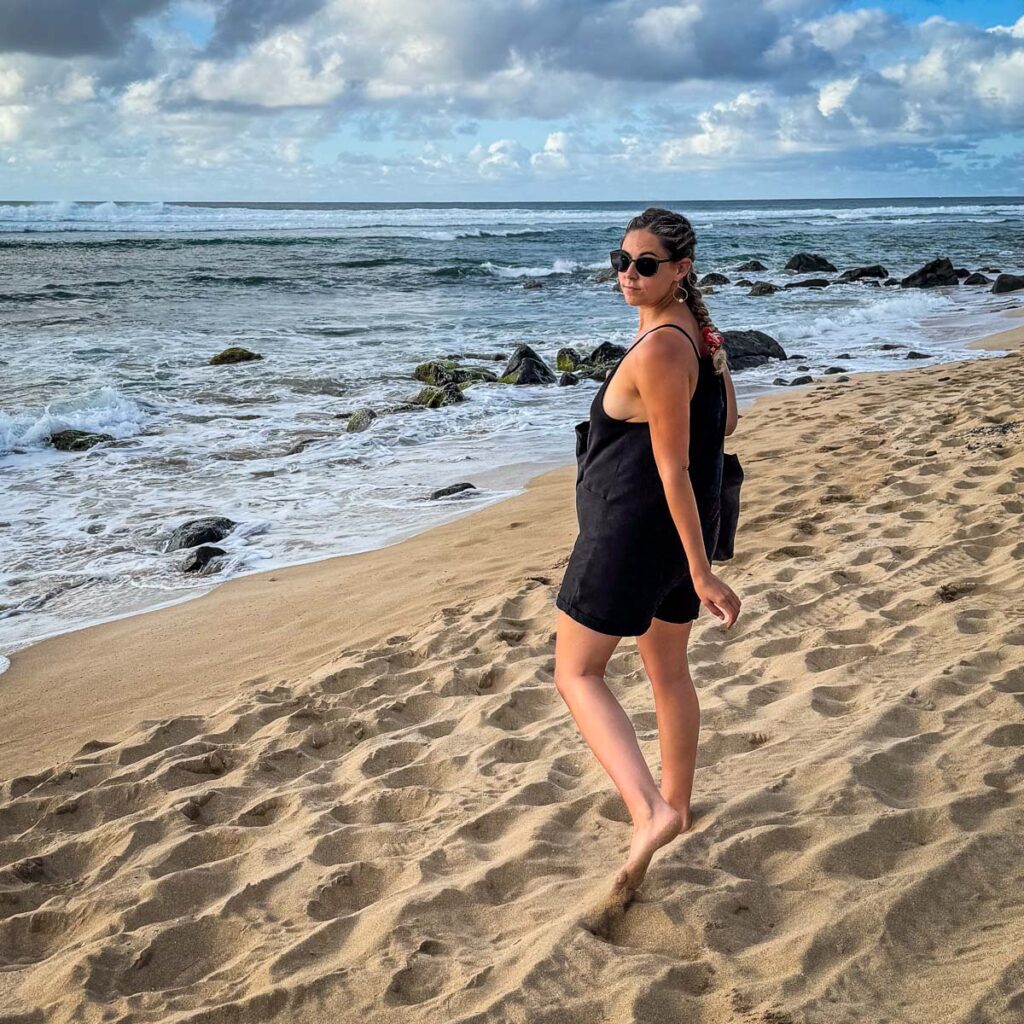
About the guest author
After spending a lifetime visiting and traveling across Oahu, Rachel considers the island her second home. She is dedicated to helping travelers understand the ins and outs of the island through her blog, Oahu Travel Secrets. Most importantly, she emphasizes the privilege of visiting and the responsibility to malama ‘aina—to honor and care for the land.
Planning a trip to Hawaii?
We have lots of resources on travel in Hawaii and destinations around the islands. Check out our Hawaii Homepage for everything you need to know, or start by reading some of our favorite Hawaii travel articles here:
- Hawaii Trip Planner: Your Dream Hawaiian Vacation Guide
- How Much Does a Trip to Hawaii Cost? (+ tips to save!)
- Best Time to Visit Hawaii: When to Go & When to Avoid!
- Best Things to Do in Hawaii: Ultimate Bucket List + Tips
Save this article on Pinterest for later!
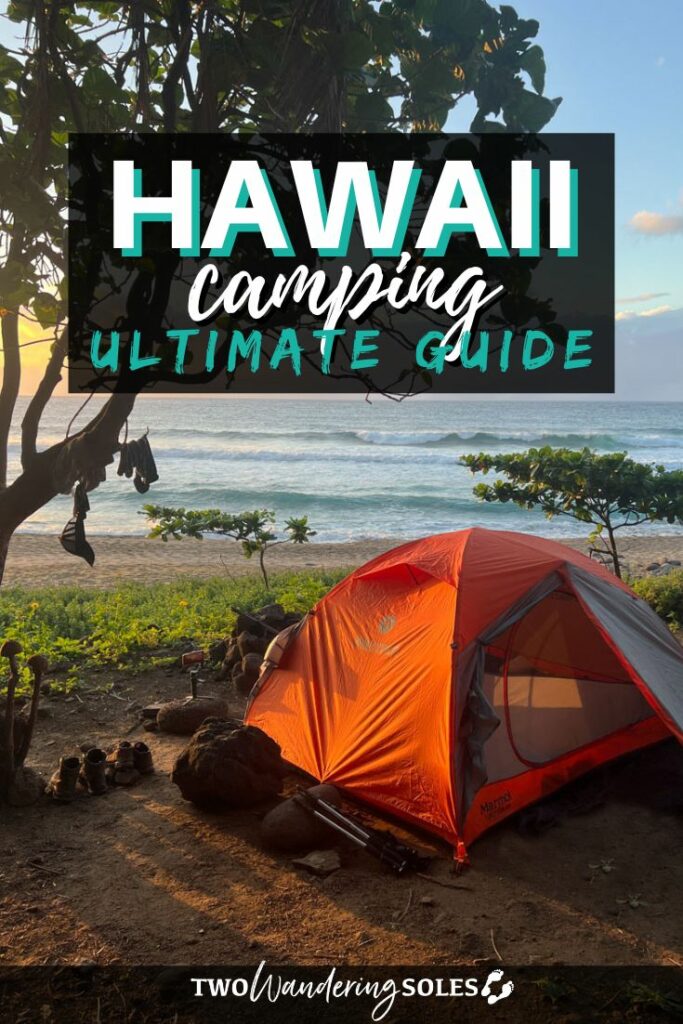
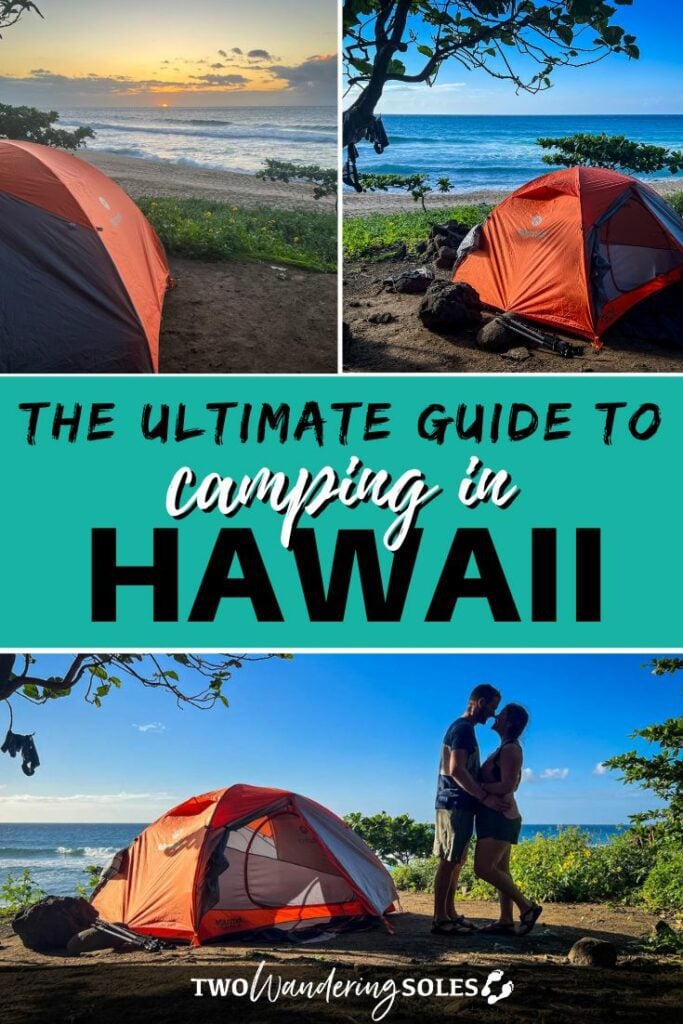
We want to hear from you!
Are you planning a Hawaii camping trip and still have questions? Leave us a comment below and we’ll do our best to find you the answers you’re looking for!

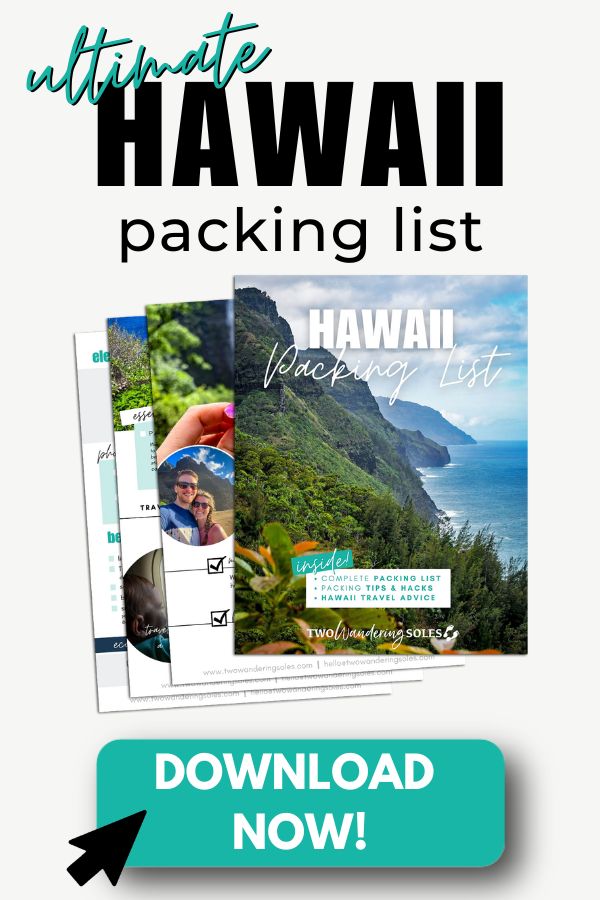
Wow! Your photography forced me to read the post, I can understand how much hard work you put in behind making this post look so beautiful. Things don’t look pretty just like that, you didn’t leave any point while gathering information. Very useful post for me and for all travel lovers. Thank you.